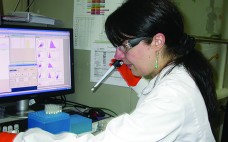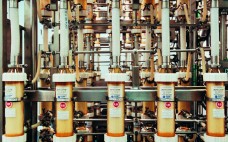Cells have become essential in modern medicine as therapies, vehicles for producing high‑value therapeutics, and tools for high‑throughput screening of pharmaceutical compounds. In the latter area, more than 50% of drug discovery screens use cell‑based assays, predominantly targeting receptors and ion channels using fluorescence‑based measurements, in either or both high‑ throughput and high‑content formats (1). Alongside a cell therapy market estimated to be worth some $5.0 billion by 2015 (2), the larger cell‑ based screening market is estimated to be…
2015
Development of a High-Throughput Formulation Screening Platform for Monoclonal Antibodies
The goal of formulation development for therapeutic proteins is to find conditions under which a protein remains stable during storage, transport, and delivery to patients. Both chemical and physical stability must be considered. Chemical stability is related to the rates of chemical modification to a protein molecule such as deamidation of aspargine residues and oxidation of methionine residues (1, 2). Particularly important to control if they affect biological function, those modifications could also lead to changes in conformation or half-life…
Fluid Dynamics of a Single-Use, Stirred-Tank Bioreactor for Mammalian Cell Culture
The benefits of single-use technologies in both upstream and downstream operations are now widely acknowledged by the biopharmaceutical industry, and have led to radical changes in the design and operation of many bioprocesses. Those changes typically provide more robust processes and increased production flexibility. For mammalian cell culture, cleanable multiuse glass or stainless steel stirred-tank reactors (STRs) have been used successfully for growth of suspension-adapted cell lines in both small- and large-scale systems. However, achieving the same or better performance…
Elucidation: The Medical Products Industry Must Resist the Pharmaphobes
I often ask people: “Do you think medical practice is better, worse, or the same compared with what it was when I graduated from medical school nearly 50 years ago?” The most common answer is “I guess it’s somewhat better,” although some say “Worse!” I explain that the unequivocal right answer is “hugely better!” For example, our average lifespan is now a decade longer, and we suffer far less from incapacitating diseases such as arthritis. Then I ask, “Why are…
Introducing Novo Nordisk Pharmatech: A Rebranding Initiative Transforms the Former FEF Chemicals
In June of this year, Leah Rosin, BPI’s marketing and digital content strategist, spoke with Rasmus Hother Le Fevre, managing director and corporate vice president, Novo Nordisk Pharmatech A/S (formerly FeF Chemicals A/S), about the company’s rebranding initiative. She began by asking him about the company’s history and reason for the name change to Novo Nordisk Pharmatech A/S. Le Fevre: Novo Nordisk Pharmatech was established in 1949 as FeF Chemicals, acquired by Novo Nordisk in 1986, and has been part…
From the Organizers of IBC’s BioProcess International Conference and Exposition
IBC’s BioProcess International Conference and Exposition (BPI) is the largest bioprocessing event currently offered to our industry, bringing you new ideas, demystifying technology, and fostering partnerships in highly engaging formats to move drug candidates closer to approval. This year’s event will be held 26–29 October 2015 at the Hynes Convention Center in Boston, MA. BPI is engineered to be exactly what you need it to be. Formal and informal networking experiences connect you to peers, prospects, and customers. Parallel tracks…
Cell Culture, Upstream – BioProcess International Conference & Exposition 2015
What’s on the minds of groups involved in cell culture and fermentation in 2015? They’re looking to implement genomics and other “-omics” technologies in cell-line development and engineering. They’re working with new analytical tools to model, monitor, and control upstream production bioprocesses. Many are interested in the possibilities of perfusion and other continuous processes. They want the most sophisticated single-use options developed with modern bioprocessing in mind. They’re adapting cell culture knowledge to new product modalities and applying all this…
Recovery and Purification – BioProcess International Conference & Exposition 2015
During the past decade, biomanufacturers have faced increasing bottlenecks, process times, and operation costs in their downstream processing. That has led many companies to reevaluate their traditional methods and technologies and consider replacing or supplementing them with strategies for reducing the number of purification steps and leveraging more efficient, less expensive, and well- understood approaches. Some strategies to enhance efficiency have focused on optimizing recovery and initial clarification processes, especially when removing host-cell proteins (HCPs). Although HCPs are an essential…
Manufacturing Strategy – BioProcess International Conference & Exposition 2015
Biomanufacturers are striving for leaner and more flexible processing, and it’s paying off. Reports received at BPI are showing that companies are improving the efficiency and robustness of their processes, and some are making changes in facility and process designs. Multiproduct, closed-system, and “portable” manufacturing facilities are helping manufacturers meet capacity demands. And additional competition from biosimilars makers has pushed some companies toward further expanding their commercial market as their original biologics come off patent. Contract manufacturing in general is…
Drug-Product Development – BioProcess International Conference & Exposition 2015
What’s on the minds of groups involved in drug-product manufacturing in 2015? They’re applying quality by design (QbD) principles and process analytical technology (PAT) to formulation and fill–finish. High- throughput and single-use technologies are helping them improve process economics as well as sterility and flexibility. Formulators are redrawing the lines between drug substance and drug product manufacturing, especially when it comes to preformulation analysis. Fill–finish groups are working out the details of new types of container– closures and delivery devices.…








